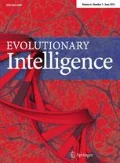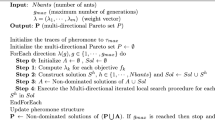Abstract
The multiobjective multidimensional knapsack problem (MOMKP) is an extension of the multiobjective knapsack problem that consists in selecting a subset of items in order to maximize m objective functions. The MOMKP creates an additional difficulty than the monodimensional version caused by the fact of respecting more than one constraint simultaneously. In this paper, we propose to solve the MOMKP with an ant colony optimization approach based on a gradual weight generation method, named Gw-ACO. Here, the weight vectors are gradually distributed in the objective space and change relatively to the optimization process. This enables ants to target, at each cycle, different regions in order to try to achieve almost all solutions covering the Pareto front. To evaluate the suggested Gw-ACO approach, a set of experiments is performed on MOMKP benchmark instances and compared with well-known state-of-the-art metaheuristic approaches. The obtained experimental results show that Gw-ACO is significantly better and able to achieve a well distribution all over the Pareto-optimal front.














Similar content being viewed by others
References
AbdelBasset M, ElShahat D, ElHenawy I, Sangaiah AK (2018) A modified flower pollination algorithm for the multidimensional knapsack problem: human-centric decision making. Soft Comput 22(13):4221–4239
AbdelBasset M, ElShahat D, Mirjalili S (2018) A hybrid whale optimization algorithm based on local search strategy for the permutation flow shop scheduling problem. Future Gener Comput Syst 85:129–145
AbdelBasset M, Manogaran G, AbdelFatah L, Mirjalili S (2018) An improved nature inspired meta-heuristic algorithm for 1-D bin packing problems. Person Ubiq Comput 2018:1–16
AbdelBasset M, ElShahat D, ElHenawy I (2018) Solving 0–1 knapsack problem by binary flower pollination algorithm. Neural Comput Appl 2018:1–19
AbdelBasset M, ElShahat D, Sangaiah AK (2017) A modified nature inspired meta-heuristic whale optimization algorithm for solving 0–1 knapsack problem. Int J Mach Learn Cybern 2017:1–20
Martello S, Toth P (1990) Knapsack problems: algorithms and computer implementations. Wiley, New York
Shih H (2005) Fuzzy approach to multilevel knapsack problems. Comput Math Appl 49(7–8):1157–1176
Smeraldi F, Malacaria P (2014) How to spend it: optimal investment for cyber security. In: Proceedings of the 1st international workshop on agents and CyberSecurity, ACySe
Ehrgott M, Ryan DM (2002) Constructing robust crew schedules with bicriteria optimization. J Multi-Criteria Decis Anal 11(3):139–150
Zitzler E, Laumanns M, Thiele L (2001) SPEA2: improving the strength pareto evolutionary algorithm for multiobjective optimization. In Giannakoglou K (eds) Evolutionary methods for design, optimisation and control with application to industrial problems (EUROGEN 2001). International Center for Numerical Methods in Engineering (CIMNE), pp 95–100
Deb K, Pratap A, Agarwal S, Meyarivan T (2002) A fast and elitist multi-objective genetic algorithm: NSGA-II. IEEE Trans Evol Comput 6(2):181–197
Lust T, Teghem J (2008) Memots: a memetic algorithm integrating tabu search for combinatorial multiobjective optimization. RAIRO Oper Res 42(1):3–33
Alsheddy A, Tsang EPK (2009) Guided pareto local search and its application to the 0/1 multi-objective knapsack problems. In: Proceedings of the eighth metaheuristic international conference (MIC09). Hamburg
Barán B, Schaerer M (2003) A multiobjective ant colony system for vehicle routing problem with time windows. In: Proceedings of twenty first IASTED international conference on applied informatics, Insbruck, Austria, pp 97–102
Ippolito MG, Morana G, Sanseverino ER, Vuinovich F (2005) Ant colony search algorithm for optimal strategical planning of electrical distribution systems expansion. Appl Intell 23:139–152
Angus D, Woodward C (2009) Multiple objective ant colony optimisation. Swarm Intell 3:69–85
Chica M, Cordón Ó, Damas S, Bautista J (2015) Interactive preferences in multiobjective ant colony optimisation for assembly line balancing. Soft Comput 19:2891–2903
Zouari W, Alaya I, Tagina M (2017) A hybrid ant colony algorithm with a local search for the strongly correlated knapsack problem. In: Computer systems and applications (AICCSA), 2017 IEEE/ACS 14th international conference on IEEE, pp 527–533
Roeva O, Fidanova S, Paprzycki M (2018) Comparison of different ACO start strategies based on intercriteria analysis. Recent advances in computational optimization. Springer, Cham, pp 53–72
Shelokar P (2018) Ant colony system: application for the single and multi-objective multidimensional knapsack problems, 2017. Math Res Summ 2:27
Alaya I, Solnon C, Ghédira K (2007) Ant colony optimization for multi-objective optimization problems. In: 19th IEEE international conference on tools with artificial intelligence (ICTAI’07), pp 450–457
Ben Mansour I, Alaya I (2015) Indicator based ant colony optimization for multi-objective Knapsack problem. Procedria Comput Sci KES Singapore 60:448–457
Ulungu EL, Teghem J, Fortemps Tuyttens D (1999) MOSA method: a tool for solving multiobjective combinatorial optimization problems. J Multi-Criteria Decis Anal 8(4):221–236
Paquete L, Stützle T (2006) A study of stochastic local search algorithms for the biobjective QAP with correlated flow matrices. Eur J Oper Res 169(3):943–959
Zhang Q, Li H (2007) MOEA/D: a multiobjective evolutionary algorithm based on decomposition. IEEE Trans Evol Comput 6(11):712–731
Lust T, Teghem J (2012) The multiobjective multidimensional knapsack problem: a survey and a new approach. Int Trans Oper Res 19(4):495–520
Angel E, Bampis E, Gourvs L (2004) A dynasearch neighborhood for the bicriteria traveling salesman problem. In: Gandibleux X, Sevaux M, Srensen K, Tkindt V (eds) Metaheuristics for multiobjective optimisation. Lecture notes in economics and mathematical systems, vol 535. Springer, Berlin
Paquete L, Chiarandini M, Sttzle T (2004) Pareto local optimum sets in the biobjective traveling salesman problem: an experimental study. In: Gandibleux X, Sevaux M, Srensen K, Tkindt V (eds) Metaheuristics for multiobjective optimisation. Lecture notes in economics and mathematical systems, vol 535. Springer, Berlin
Ahuja RK, Ergun Ö, Orlin JB, Punnen AP (2002) A survey of very large-scale neighborhood search techniques. Discret Appl Math 123:75–102
Iredi S, Merkle D, Middendorf M (2001) Bi-criterion optimization with multi colony ant algorithms. In: First international conference on evolutionary multi-criterion optimization (EMO01). Lecture notes in computer science, pp 359–372
Angus D (2007) Crowding population-based ant colony optimisation for the multi-objective travelling salesman problem. In: IEEE symposium on computational intelligence in multi-criteria decision-making (MCDM), pp 333–340
Liangjun K, Qingfu Z, Battiti R (2013) MOEA/D-ACO: a multiobjective evolutionary algorithm using decomposition and AntColony. IEEE Trans Cybern 43(6):1845–59
Dorigo M, Maniezzo V, Colorni A (1991) Positive feedback as a search strategy. Technical report 91–016. Dipartimento di Elettronica, Politecnico di Milano, Milan, Italy
Stützle T, Hoos H (1998) MAX-MIN ant system and local search for combinatorial optimization problems, meta-heuristics: advances and trends in local search paradigms for optimization. Kluwer Academics, Boston
Dorigo M (1992) Optimization learning, natural algorithms (in Italian). PhD thesis, Dipartimento di Elettronica, Politecnico di Milano, Italy
Mariano C E, Morales E (1999) A multiple objective ant-q algorithm for the design of water distribution irrigation networks. Technical report n HC-9904. Instituto Mexicano de Tecnologa del Agua, Mexico
Gravel M, Price WL, Gagne C (2002) Scheduling continuous casting of aluminium using a multiple objective ant colony optimization metaheuristic. Eur J Oper Res 143(1):218–229
McMullen PR (2001) An ant colony optimization approach to addressing a JIT sequencing problem with multiple objectives. Artif Intell Eng 15(3):309–317
López-Ibáñez M, Stützle T (2010) The impact of design choices of multi-objective ant colony optimization algorithms on performance: an experimental study on the biobjective TSP. In: GECCO 2010. ACM press, New York, pp 71–78
Dörner K, Gutjahr WJ, Hartl RF, Strauss C, Stummer C (2004) Pareto ant colony optimization: a metaheuristic approach to multiobjective portfolio selection. Ann Oper Res 131(1–4):79–99
Gambardella L, Taillard ED, Agazzi G (1999) MACS-VRPTW: a multiple ant colony system for vehicle routing problems with time windows. In: Corne FGD, Dorigo M (eds) New ideas in optimization. McGraw Hill, London, pp 63–76
Bullnheimer B, Hartl RF, Strauss C (1999) An improved ant system algorithm for the vehicule routing problem. Ann Oper Res 89:319–328
Doerner K, Hartl RF, Teiman M (2003) Are COMPETants more competent for problem solving? The case of full truckload transportation. Cent Eur J Oper Res 11(2):115–141
Alaya I, Solnon C, Ghédira K (2004) Ant algorithm for the multi-dimensional knapsack problem. In: Proceedings of international conference on bioinspired optimization methods and their applications (BIOMA), pp 63–72
Garcia-Martinez C, Cordon O, Herrera F (2007) A taxonomy and an empirical analysis of multiple objective ant colony optimization algorithms for bi-criteria tsp. Eur J Oper Res 180(1):116–148
Zitzler E, Thiele L (1999) Multiobjective evolutionary algorithms: a comparative case study and the strength pareto approach. IEEE Trans Evol Comput 3(4):257–271
Grunert da Fonseca V, Fonseca C M, Hall A O (2001) Inferential performance assessment of stochastic optimisers and the attainment function. In: 1st international conference on evolutionary multi-criterion optimization (EMO (2001). Lecture note in computer science. Springer, Berlin, pp 213–225
Knowles J D, Thiele L, Zitzler E (2005) A tutorial on the performance assessment of stochastive multiobjective optimizers. Technical report TIK-Report No. 214. Computer Engineering and Networks Laboratory, ETH Zurich
Zitzler E, Brockhoff D, Thiele L (2007) The hypervolume indicator revisited: on the design of pareto-compliant indicators via weighted integration. In: International conference on evolutionary multi-criterion optimization. Springer, Berlin, pp 862–876
Emmerich M, Beume N, Naujoks B (2005) An EMO algorithm using the hypervolume measure as selection criterion. In: International conference on evolutionary multi-criterion optimization. Springer, Berlin, pp 62–76
Das I, Dennis JE (1997) A closer look at drawbacks of minimizing weighted sums of objectives for Pareto set generation in multicriteria optimization problems. Struct Optim 14(1):63–69
Vahidinasab V, Jadid S (2010) Normal boundary intersection method for suppliers’ strategic bidding in electricity markets: an environmental/economic approach. Energy Convers Manag 51(6):1111–1119
Author information
Authors and Affiliations
Corresponding author
Additional information
Publisher’s Note
Springer Nature remains neutral with regard to jurisdictional claims in published maps and institutional affiliations.
Rights and permissions
About this article
Cite this article
Ben Mansour, I., Alaya, I. & Tagina, M. A gradual weight-based ant colony approach for solving the multiobjective multidimensional knapsack problem. Evol. Intel. 12, 253–272 (2019). https://doi.org/10.1007/s12065-019-00222-9
Received:
Revised:
Accepted:
Published:
Issue Date:
DOI: https://doi.org/10.1007/s12065-019-00222-9




